-
Countries
-
Data and Analysis
-
Special Focus
-
Crisis Responses
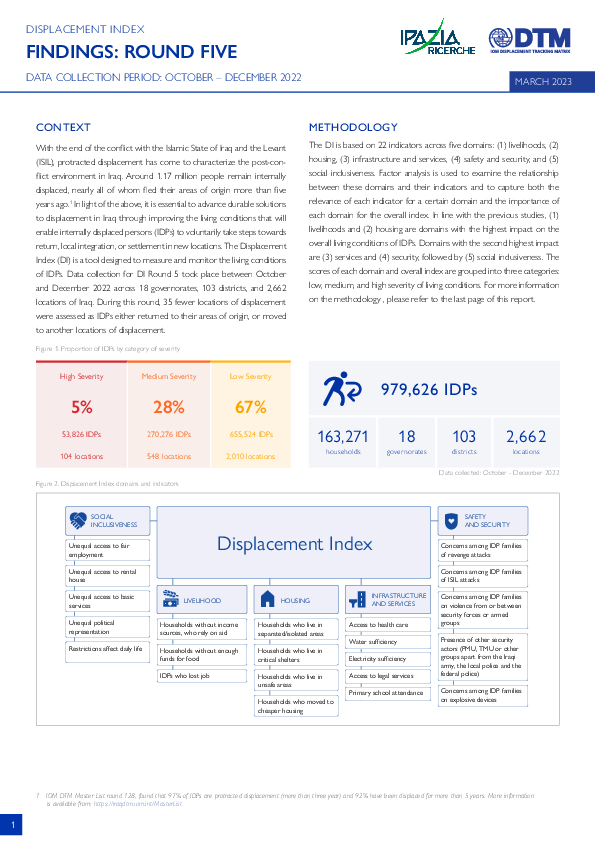
Contact
IraqDTM@iom.int
Language
English
Location
Iraq
Period Covered
Oct 01 2022
Dec 01 2022
Activity
- Survey
With the end of the conflict with the Islamic State of Iraq and the Levant (ISIL), protracted displacement has come to characterize the post-conflict environment in Iraq. Around 1.17 million people remain internally displaced, nearly all of whom fled their areas of origin more than five years ago.1 In light of the above, it is essential to advance durable solutions to displacement in Iraq through improving the living conditions that will enable internally displaced persons (IDPs) to voluntarily take steps towards return, local integration, or settlement in new locations. The Displacement Index (DI) is a tool designed to measure and monitor the living conditions of IDPs. Data collection for DI Round 5 took place between October and December 2022 across 18 governorates, 103 districts, and 2,662 locations of Iraq. During this round, 35 fewer locations of displacement were assessed as IDPs either returned to their areas of origin, or moved to another locations of displacement.
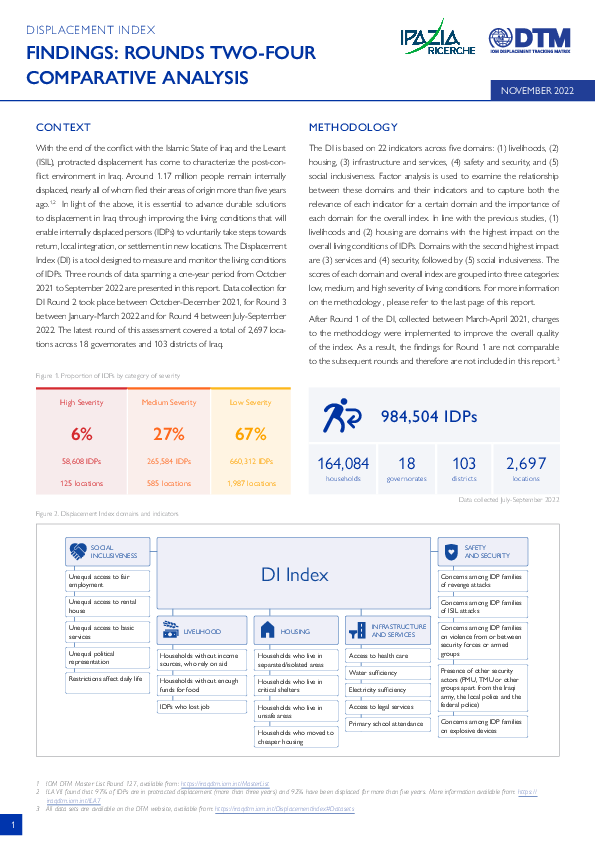
Contact
IraqDTM@iom.int
Language
English
Location
Iraq
Period Covered
Oct 01 2021
Sep 01 2022
Activity
- Survey
With the end of the conflict with the Islamic State of Iraq and the Levant (ISIL), protracted displacement has come to characterize the post-conflict environment in Iraq. Around 1.17 million people remain internally displaced, nearly all of whom fled their areas of origin more than five years ago.1,2 In light of the above, it is essential to advance durable solutions to displacement in Iraq through improving the living conditions that will enable internally displaced persons (IDPs) to voluntarily take steps towards return, local integration, or settlement in new locations. The Displacement Index (DI) is a tool designed to measure and monitor the living conditions of IDPs. Three rounds of data spanning a one-year period from October 2021 to September 2022 are presented in this report. Data collection for DI Round 2 took place between October-December 2021, for Round 3 between January-March 2022 and for Round 4 between July-September 2022. The latest round of this assessment covered a total of 2,697 locations across 18 governorates and 103 districts of Iraq.
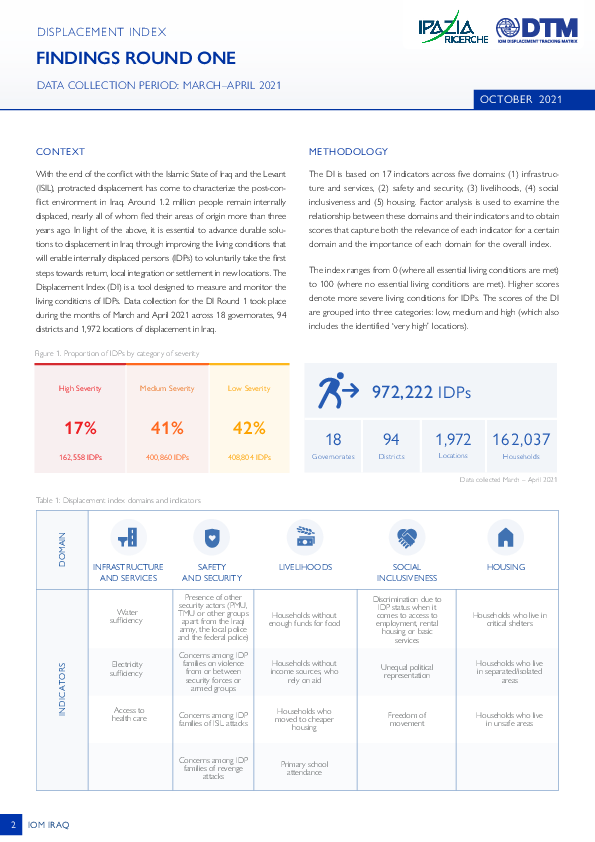
Contact
IraqDTM@iom.int
Language
English
Location
Iraq
Period Covered
Mar 01 2021
Apr 01 2021
Activity
- Survey
With the end of the conflict with the Islamic State of Iraq and the Levant (ISIL), protracted displacement has come to characterize the post-conflict environment in Iraq. Around 1.2 million people remain internally displaced, nearly all of whom fled their areas of origin more than three years ago. In light of the above, it is essential to advance durable solutions to displacement in Iraq through improving the living conditions that will enable internally displaced persons (IDPs) to voluntarily take the first steps towards return, local integration or settlement in new locations. The Displacement Index (DI) is a tool designed to measure and monitor the living conditions of IDPs. Data collection for the DI Round 1 took place during the months of March and April 2021 across 18 governorates, 94 districts and 1,972 locations of displacement in Iraq.
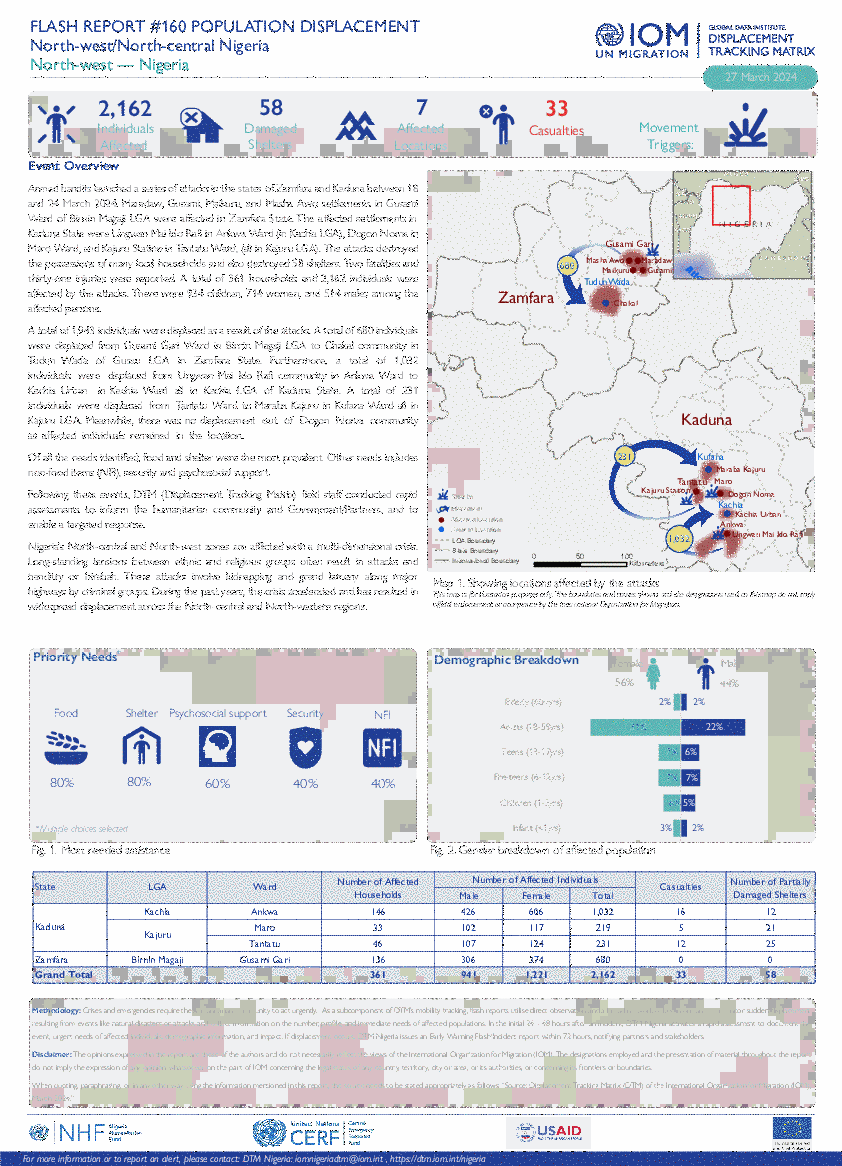
Contact
DTM Nigeria, iomnigeriadtm@iom.int
Language
English
Location
Nigeria
Period Covered
Mar 18 2024
Mar 24 2024
Activity
- Mobility Tracking
- Event Tracking
Armed bandits launched a series of attacks in the states of Zamfara and Kaduna between 18 and 24 March 2024. Maradaw, Gusami, Maikuru, and Masha Awo settlements in Gusami Ward of Birnin Magaji LGA were affected in Zamfara State. The affected settlements in Kaduna State were Ungwan Mai Ido Rafi in Ankwa Ward (in Kachia LGA), Dogon Noma in Maro Ward, and Kajuru Station in Tantatu Ward, (all in Kajuru LGA). The attacks destroyed the possessions of many local households and also destroyed 58 shelters. Two fatalities and thirty-one injuries were reported. A total of 361 households and 2,162 individuals were affected by the attacks. There were 934 children, 714 women, and 514 males among the affected persons.
A total of 1,943 individuals were displaced as a result of the attacks. A total of 680 individuals were displaced from Gusami Gari Ward in Birnin Magaji LGA to Chakal community in Tudun Wada of Gusau LGA in Zamfara State. Furthermore, a total of 1,032 individuals were displaced from Ungwan Mai Ido Rafi community in Ankwa Ward to Kachia Urban in Kachia Ward all in Kachia LGA of Kaduna State. A total of 231 individuals were displaced from Tantatu Ward to Maraba Kajuru in Kufana Ward all in Kajuru LGA. Meanwhile, there was no displacement out of Dogon Noma community as affected individuals remained in the location.
Of all the needs identified, food and shelter were the most prevalent. Other needs include non-food items (NFI), security and psychosocial support.

Contact
DTM Nigeria, iomnigeriadtm@iom.int
Language
English
Location
Nigeria
Period Covered
Mar 11 2024
Mar 17 2024
Activity
- Mobility Tracking
- Event Tracking
On 15 March 2024, armed bandits attacked the communities of Balisa, Jimrawa, Kaura Zomo and Sodingo in Dan Isa ward of Kaura Namoda LGA in Zamfara State. The attacks caused one fatality but no injuries were reported. The attacks affected 2,240 individuals in 373 households. The affected individuals included 1,257 children, 541 women and 442 men.
Of all the needs identified, food and security were the most prevalent. Other needs included shelter and non-food items (NFI).
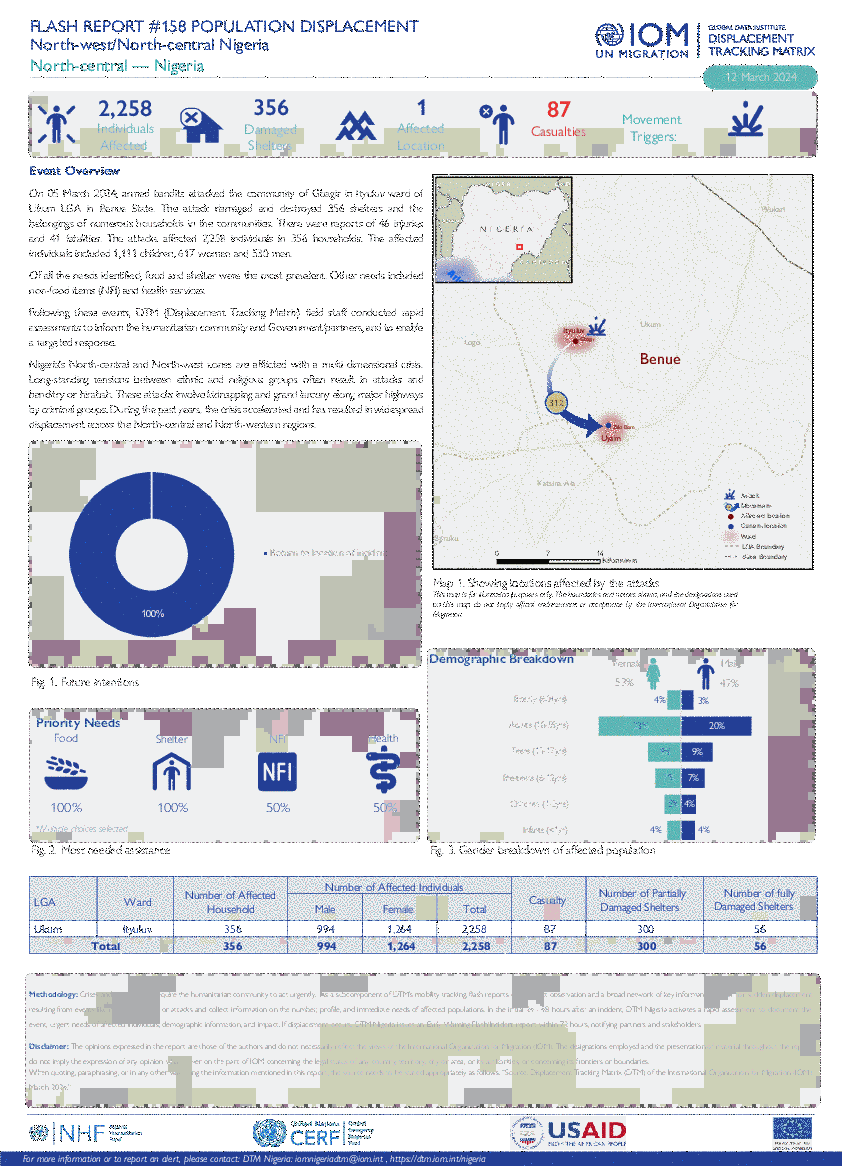
Contact
DTM Nigeria, iomnigeriadtm@iom.int
Language
English
Location
Nigeria
Period Covered
Mar 04 2024
Mar 10 2024
Activity
- Mobility Tracking
- Event Tracking
On 05 March 2024, armed bandits attacked the community of Gbagir in Ityuluv ward of Ukum LGA in Benue State. The attack damaged and destroyed 356 shelters and the belongings of numerous households in the communities. There were reports of 46 injuries and 41 fatalities. The attacks affected 2,258 individuals in 356 households. The affected individuals included 1,111 children, 617 women and 530 men.
Of all the needs identified, food and shelter were the most prevalent. Other needs included non-food items (NFI) and health services.
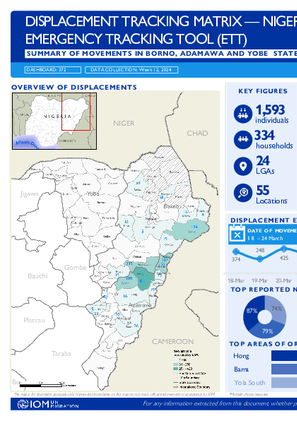
Contact
DTM Nigeria, iomnigeriadtm@iom.int
Language
English
Location
Nigeria
Period Covered
Mar 18 2024
Mar 24 2024
Activity
- Mobility Tracking
- Event Tracking
Between 18 and 24 March 2024, a total of 1,593 new arrivals were recorded at locations in Adamawa and Borno states. The new arrivals were recorded at locations in Askira/Uba, Bama, Dikwa, Gubio, Gwoza, Hawul, Kaga, Kala Balge, Konduga and Monguno Local Government Areas (LGAs) of the most conflict-affected Borno State, in Fufore, Gombi, Guyuk, Hong, Lamurde, Madagali, Maiha, Michika, Mubi North, Mubi South, Numan, Song, Yola North and Yola South LGAs of Adamawa State.
ETT assessments identified the following movement triggers: attack (380 individuals or 24%), family re-unification (366 individuals or 23%), improved security (265 individuals or 16%), fear of attack (213 individuals or 13%), poor living conditions (139 individuals or 9%), seasonal farming (89 individuals or 6%), access to humanitarian support (75 individuals or 5%) and military operation (66 individuals or 4%).

Contact
DTM Nigeria, iomnigeriadtm@iom.int
Language
English
Location
Nigeria
Period Covered
Mar 11 2024
Mar 17 2024
Activity
- Mobility Tracking
- Event Tracking
Between 11 and 17 March 2024, a total of 1,409 new arrivals were recorded at locations in Adamawa and Borno states. The new arrivals were recorded at locations in Askira/Uba, Bama, Biu, Damboa, Dikwa Gwoza, Hawul and Monguno Local Government Areas (LGAs) of the most conflict-affected Borno State, in Fufore, Girei, Gombi, Guyuk, Hong, Lamurde, Madagali, Maiha, Michika, Mubi North, Song, Yola North and Yola South LGAs of Adamawa State.
ETT assessments identified the following movement triggers: family re-unification (435 individuals or 31%), military operation (291 individuals or 20%), poor living conditions (266 individuals or 19%), seasonal farming (173 individuals or 12%), improved security (136 individuals or 10%), fear of attack (98 individuals or 7%) and access to humanitarian support (10 individuals or 1%).
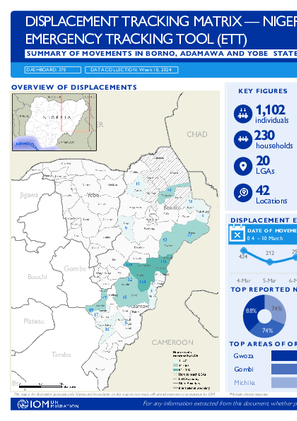
Contact
DTM Nigeria, iomnigeriadtm@iom.int
Language
English
Location
Nigeria
Period Covered
Mar 04 2024
Mar 10 2024
Activity
- Mobility Tracking
- Event Tracking
Between 04 and 10 March 2024, a total of 1,102 new arrivals were recorded at locations in Adamawa and Borno states. The new arrivals were recorded at locations in Askira/Uba, Bama, Gubio, Gwoza, Kaga, Kala Balge, Monguno and Ngala Local Government Areas (LGAs) of the most conflict-affected Borno State, in Fufore, Girei, Gombi, Guyuk, Hong, Lamurde, Madagali, Maiha, Mayo Belwa, Michika, Mubi North, Mubi South, Numan, Song, Yola North and Yola South LGAs of Adamawa State and in Geidam and Gulani LGAs of Yobe State.
ETT assessments identified the following movement triggers: poor living conditions (321 individuals or 46%), family re-unification (256 individuals or 23%), improved security (182 individuals or 17%), seasonal farming (144 individuals or 13%), military operations (77 individuals or 7%), access to humanitarian support (72 individuals or 6%) and fear of attack (50 individuals or 5%).
Contact
mtmtajikistan@iom.int
Location
Tajikistan
Activity
- Mobility Tracking
Period Covered
Sep 13 2023 -Nov 11 2023
The surveys were conducted with return migrant workers using IOM’s Mobility Tracking Matrix (MTM) system in Tajikistan. The survey locations were selected based on the results of IOM’s Baseline Mobility Assessment on returning migrant workers. The report includes findings on socio-economic profile, migration experience, employment and remittances. The survey sample was calculated based on a Baseline Assessment on the presence of returning migrant workers in the selected locations. The interviews were conducted using mobile devices and the KoBo software. All interviews were anonymous, and IOM’s Data Protection Principles were observed throughout the entire data cycle. Data collectors approached potential respondents using the snowball method to obtain their informed consent.
Population Groups
Migrants Present
Survey Methodology
Unit of Analysis Or Observation
Admin Area 2
Individual
Type of Survey or Assessment
Household
Keywords
Geographical Scope Full Coverage
Administrative boundaries with available data
The current dataset covers the following administrative boundaries
